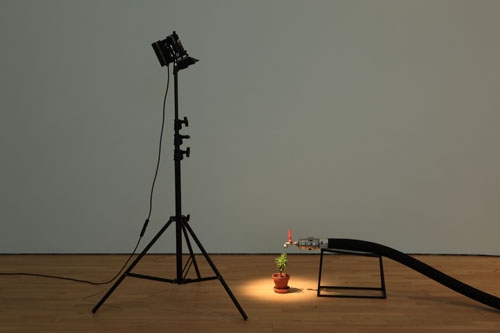In the last few years, there has been a trend in artistic practice towards work that displays the rather ponderous body of a narrative in a minimal cloak. Childhood memories, illness or reflections on consumerism – themes that can, in themselves, quickly come across as unclean, wearying and self-pitying – undergo a type of beauty treatment and present themselves in an elegant outfit that at first glance exudes delicacy and meekness before the moment of surprise strikes. In many cases this leads to an aesthetic that implicitly combines ‘smooth’ and ‘art’ in a casual design coup: smart. This is also how Wilfredo Prieto’s exhibition appears in S.M.A.K., Belgium’s most exciting museum for art post-1945.
Prieto, born in Cuba in 1978 (where he still lives), starts by leaving a huge room empty except for two very light parallel lines on the wall: one drawn with a Montblanc pen, the other with a no-name fountain pen. One can only guess whether the clean line is from the more expensive pen, and one can meanwhile view the wall as an enormous canvas on which a horizon, and therefore a landscape, now exists. The delicate poetry that stems from this formal gesture lasts, however, no longer than the blink of an eye – Prieto’s mischievous conceptual wink deters any deeper immersion. In subsequent rooms, everyday materials serve as nonchalant short commentaries on the global goings-on of the (art) consumer society: a smartphone is fastened to a mango with a rubber band, a diamond the size of a grain of dust is placed unprotected on the floor like an anti-Land art statement and a huge ball of plastic wrap sits in the room as if Sisyphus had forgotten it. The idea that less can also be more is quickly understood when a dollar bill is presented between two mirrors. (Necessary background information: the endless reflection warrants an insurance value of one million dollars.) The puddle formed by a drip from the ceiling also has an unofficial story: the murky water was blessed by a priest.
Prieto’s ‘Baroque minimalism’, according to an accompanying text, means first reducing materiality to the banal and then loading it with narrative – and in this regard Prieto relies also on the trompe l’oeil effect. Similar to how sixteenthcentury artists reached into the bag of perspective tricks and painted fake windows on the ceiling, Prieto plays with our perception: see the small houseplant that, it turns out, is supplied, drop by drop, with water from an enormous hose that leads through the entire building to a huge container outside. The rough vocabulary of classic conceptual art is naturally, and above all freely and in a tongue-in-cheek manner, carried over into a cunning grammar that, at times, feels inescapable. In a playful and symbolic way, Prieto’s compositions update the institutional critique of old conceptual art for the global age, where they make fun of the tools of the art scene and the upper class. In the early 1990s Prieto’s fellow countryman Felix Gonzalez-Torres drew on the reductive aesthetics of the 1960s in order to fill them with stories about love and death; this is now the native language of a generation used to speaking laconically. In Prieto’s better moments it sounds witty, but it can often also be pretty trivial. Hiding the problematic areas of prosaic narration in an elegant form does not ultimately mean that they disappear. Perhaps the minimal cloak is like the hipster beard: in the end it’s not simply how smart something looks, but also how one wears it.
Translated from the German by Emily Terényi. This article originally appeared in the October 2014 issue
